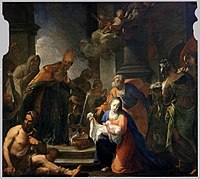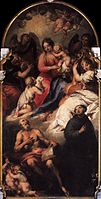Andrea Celesti

Andrea Celesti (1637–1712) was an Italian painter of the Baroque period, working in Venice. His style gravitated over the years from a turgid and academic weightiness to a lighter, looser brushstroke.
Biography
Celesti was born in Venice and is buried in
He first trained with
Legend holds Celesti, after a yearly public exhibition in the piazza San Marco, had to flee Venice when he angered Doge Contarini, when he displayed the Doge with a donkey’s ears of a donkey. He was then protected by his future patron Scipione Delaj and relocated inland. In about 1685, after some painting in Rovigo, he established a studio in Brescia.
For the Delaj family, starting in 1688, Celesti and his studio began painting a series of religious canvases for the Cathedral of Peter and Paul in
He also painted canvases for the church of
In 1689 he decorated a room in the palazzo Delay.
Andrea Celesti’s pupil included Albert Calvetti[5] and Angelo Trevisani. His son, Stefano Celesti was also a painter.
Paintings
Religious subjects
-
Madonna and Child with Saints Anne, Joachim, and Benedict, c. 1693
-
Virgin of the Grapes, c. 1690
-
Presentation of Jesus at the Temple, c. 1710
-
Queen Jezebel being punished by Jehu, c. 1650
-
King David playing the Zither, .c 1650
-
The Virgin and Child with the Infant St John Appearing to St Jerome and St Anthony, c. 1700
-
Moses saved from the water, c. 1700
-
The Holy Family, c. 1690-1700
Mythological subjects
-
Hercules and Omphale, c. 1670
-
Death of King Priam, c. 1706
Portraits
-
Portrait of Military Commander I, c. 1600s
-
Portrait of Military Commander II, c. 1600s
References
- Pignatti, Terisio (1956). "Andrea Celesti". The Burlington Magazine: 383.
- Work in Brescia.
External links
 For a Picture of Saint Cecilia attended by Angels. is a poem by Felicia Hemans in The Winter's Wreath annual for 1831 accompanying an engraving by John Henry Robinson of Celesti's painting, Saint Cecilia attended by Angels.
For a Picture of Saint Cecilia attended by Angels. is a poem by Felicia Hemans in The Winter's Wreath annual for 1831 accompanying an engraving by John Henry Robinson of Celesti's painting, Saint Cecilia attended by Angels.
Notes
- ^ Inscribed K.A.C.P.F. for Kavaliere Andrea Celesti (painter of fame)
- ^ Although he settled in Brescia in 1685.
- ^ Palazzo Delay is near Toscolano and today called Palazzo Mafizzoli
- ^ Frescoes at the villa at Casella d'Asolo are partially degraded.
- ^ *Hobbes, James R. (1849). Picture collector's manual adapted to the professional man, and the amateur. London: T&W Boone. p. 48.












